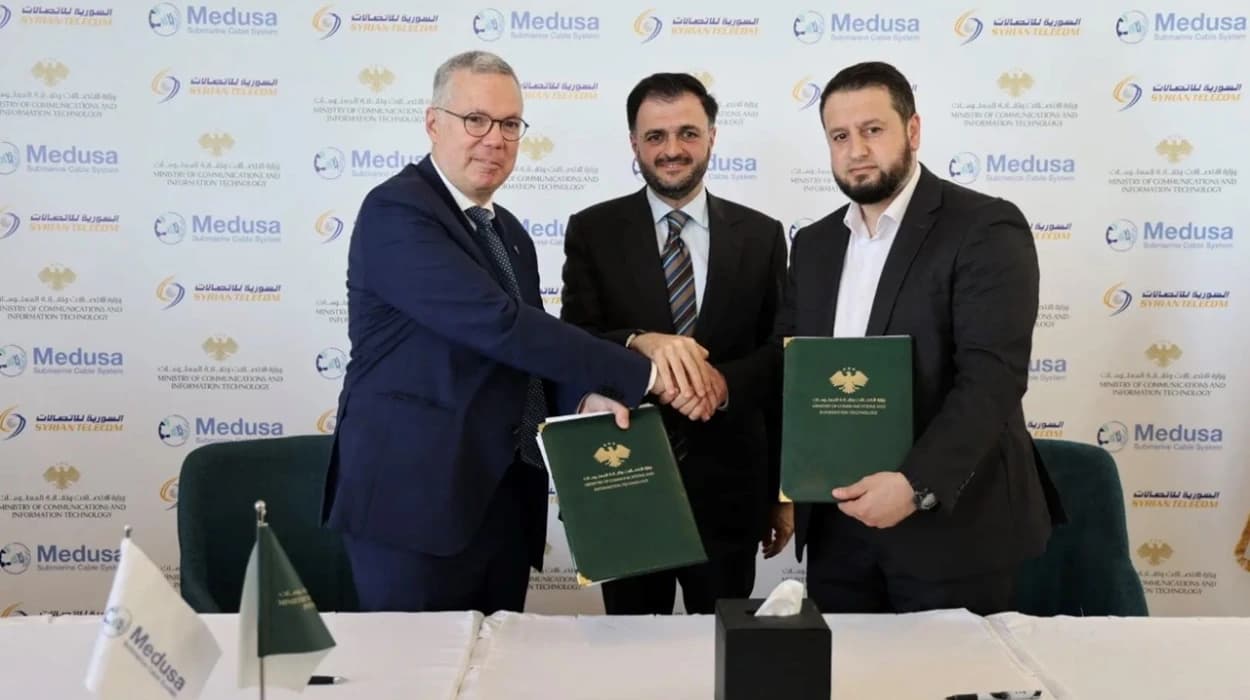Syria's telecommunications ministry has signed a landmark
agreement with Barcelona-based Medusa Submarine Cable System to land the
country's first international undersea cable, significantly upgrading Syria's
internet connectivity and digital infrastructure. The project connects Syria
with 12 countries across North Africa and southern Europe, forming a critical
data corridor linking the Mediterranean with the Atlantic Ocean and the Red
Sea, marking a pivotal step toward modernising the nation's telecommunications
and placing Syria on a regional digital map after years of conflict and
sanctions.
Landmark Agreement Brings First International Submarine Cable to Syria
As reported by Reuters and state-run Ikhbariya TV, Syria's
Ministry of Communications and Technology has officially signed an agreement
with Spain's Medusa Submarine Cable System for the landing of the nation's
first international undersea cable at the Tartous landing station. The signing
ceremony, held in the coastal province of Tartous, was attended by
Communications and Technology Minister Dr Abdulsalam Haykal and Medusa
representative Norman Albi, along with local officials from Latakia and
Tartous.
The Medusa cable system is designed to connect 12 countries
across North Africa and Southern Europe, establishing a high-capacity cable
corridor that links the Mediterranean Sea to the Atlantic Ocean and the Red
Sea. This marks Syria’s inaugural integration into the regional and global
submarine cable networks, a significant milestone after more than a decade of
connectivity challenges caused by years of civil war and broad Western
sanctions.
Strategic Importance for Syria’s Digital Infrastructure and Economy
Dr Abdulsalam Haykal highlighted the strategic importance of
the project during a site visit to the Tartous Port, stating that this
agreement is a crucial step to position Syria as a central hub for
international internet connectivity and digital trade. According to the
minister, the project aligns with the government’s ambition to rebuild Syria’s
public services and modernise its telecommunications sector following the
political transition and extended disruption.
The submarine cable is expected to significantly improve
internet capacity, speed, and reliability across Syria, reducing the
population’s dependence on costly and less reliable mobile data networks. This
development will facilitate smoother access to digital services in education,
healthcare, commerce, and public administration, while supporting the long-term
economic recovery and enabling technological innovation.
Technical Insights and Economic Impact
Engineer Alaa Al-Baghdadi, a communications network
specialist, explained to The Media Line that the cable represents “a
qualitative leap” for Syria’s telecommunications infrastructure. He emphasised
that joining the undersea cable network restores Syria’s natural place within
the regional connectivity map and will enable faster internet speeds and larger
data capacities domestically.
Al-Baghdadi further explained that this is not merely a
technical upgrade but a foundational move towards digital independence after
years of relying on indirect and vulnerable transit routes. He cautioned,
however, that the full benefits will depend on Syria’s continuation of
fibre-optic infrastructure upgrades and the technical and security measures
protecting the network.
The submarine cable's landing is expected to reduce Syria’s
operational reliance on regional overland links and satellite connections,
which have been prone to outages and restrictions influenced by geopolitical
factors. Establishing sovereign control of international data routes offers
Syria greater resilience and negotiating power over traffic and maintenance
conditions.
Part of Broader Connectivity and Reconstruction Plans
This cable landing is integrated into Syria’s broader
digital development strategy, including the “Silk Link” initiative announced by
Minister Haykal earlier in 2025, which aims to build a large-scale fibre-optic
network positioning Syria as a key digital bridge between Asia and Europe. The
Ministry is reportedly coordinating with regional telecom providers, including
Zain, Etisalat, STC, and Ooredoo, as part of an estimated $300 million plan to
upgrade Syria’s fibre-optic infrastructure and fully integrate the submarine
cable into the national broadband network.
Furthermore, earlier in the year, Syria launched the “Ugarit
2” project to enhance international digital connectivity via Cyprus with hopes
to boost internet speeds and underpin economic growth.
Regional and Global Context
The completion of this project places Syria within a larger
Mediterranean submarine cable system connecting multiple countries in North
Africa and Southern Europe. By linking diverse regions from the Mediterranean
Sea to the Atlantic Ocean and Red Sea, the cable supports increased regional
data traffic and global communications integration, which experts believe could
foster innovation in e-commerce, cloud computing, telemedicine, and digital
public services.
International telecommunications infrastructure analysts
view Syria’s entry into submarine cable networks as a transformative step after
years of isolation, potentially spurring private investment and facilitating
government digital transformation projects critical for Syria’s reconstruction
efforts.
Outlook and Challenges Ahead
While the cable’s installation marks a historic and
promising development for Syria’s digital landscape, challenges remain in
ensuring the completion of local infrastructure upgrades, securing the network
technically and politically, and providing competitive broadband pricing to
make high-speed internet widely accessible.
The government has expressed commitment to addressing these
challenges and leveraging the cable to stimulate local technological
development and economic growth, with digital infrastructure considered as
fundamental as physical infrastructure like power and transport in Syria’s
reconstruction path.
The signing and forthcoming landing of Syria’s first international submarine cable through the Medusa system represents a significant milestone in restoring and modernising the country’s telecommunications network. This development promises enhanced internet speeds, lower costs, and improved reliability for Syrian users, embedding Syria firmly back into the global digital economy despite the prolonged hardships from conflict and sanctions. As the government advances its fibre-optic and broadband development plans in partnership with regional telecom operators, this project stands as a beacon of Syria’s ongoing digital renewal and economic recovery efforts.
